Effects of State-of-Charge and Penetration Location on Variations in Temperature and Terminal Voltage of a Lithium-Ion Battery Cell during Penetration Tests
Abstract
:1. Introduction
2. Battery Cell Penetration Experiments
2.1. Experimental Preparation and Setup
2.2. Experimental Results and Discussion
3. Battery Cell Internal Short-Circuit Simulations
3.1. Simulation Setup
- The mesh of the geometry of the battery cell, which is created by the Mesh function in ANSYS, was imported into the ANSYS Fluent. The dimensions of the geometry of the cell were the same as those of the tested cells, which were 196 mm (excluding the terminals) in height, 127 mm in width, and 7 mm in thickness.
- The Multi-Scale Multi-Dimensional (MSMD) Battery Model was enabled. NTGK (Newman, Tiedemann, Gu and Kim) Empirical Model was selected as the E-Chemistry model. 20 Ah was entered as the nominal cell capacity. Specified resistance was selected as the solution option and 10,000 ohms was entered as the external resistance. Large external resistance was entered because there was no external current flow during the cell penetration tests and simulations. Minimum and maximum stop voltage were 2.5 V and 4.2 V, respectively. Initial DOD (depth of discharge) was selected based on the initial conditions of different simulations.
- Under Materials, copper was selected for the tab material. 2092 kg/m3, 678 J/kg-K, 18.4 W/m-K, and 3.541 × 107 siemens/m were entered for the density, specific heat, thermal conductivity, and electrical conductivity of the active material inside the battery cell, respectively. 1,190,000 kg/m-s and 983,000 kg/m-s were entered for uds-0 and uds-1, respectively, as the User Defined Scalar Diffusion Coefficients.
- Under Boundary Conditions, convection was selected for the thermal condition and 8 W/m2-K was entered for the heat transfer coefficient for all walls of the battery cell model. Free stream temperature was set to 25 degrees Celsius, which was same as the ambient temperature inside the laboratory room.
- Under Setting Up Domain, the locations of the penetration were marked on the battery cell geometry under the Mark/Adapt Cells function. Under Initialization, short circuit resistance was assigned to the penetration location using “Patch” function. The value of the short circuit resistance under “Patch” function is an unitless value with initial value set to 5 × 10−7. This value was adjusted to make the simulated temperature distributions on battery cell after penetration match the experimental ones. In this paper, this value was adjusted based on the experimental temperature distribution data for the cell with 50% initial SOC and Penetration Location 2 (Case 5). Experimental temperature distribution data for the Cases 2, 4, 6, and 8 were compared to the simulated data as model validation.
- Under Run Calculation, Fixed was selected as the time stepping method. Time step size was set to 30 s. Number of time steps was selected based on temperature distribution data at what time was required. For example, if temperature distribution data on the battery cell five minutes after penetration started is needed, the number of time steps should set to 10 (30 s multiplied by 10 equals to five minutes). In this paper, cell temperature data at the middle point of the “flat zone” of the temperature curve of the penetration location was used for comparison between simulated and experimental data. Temperature data at 30 min, 40 min, 40 min, 5 min, and 40 min after penetration started were selected for Cases 5, 4, 6, 2, and 8, respectively, for comparisons between simulated and experimental data.
3.2. Simulation Results and Discussion
4. Conclusions
Author Contributions
Funding
Conflicts of Interest
References
- Doughty, D.H.; Roth, E.P. A general discussion of Li Ion battery safety. Electrochem. Soc. Interface 2012, 21, 37–44. [Google Scholar] [CrossRef] [Green Version]
- Jeong, G.; Kim, Y.-U.; Kim, H.; Kim, Y.-J.; Sohn, H.-J. Prospective materials and applications for Li secondary batteries. Energy Environ. Sci. 2011, 4, 1986–2002. [Google Scholar] [CrossRef]
- Fernandes, Y.; Bry, A.; de Persis, S. Identification and quantification of gases emitted during abuse tests by overcharge of a commercial Li-ion battery. J. Power Sources 2018, 389, 106–119. [Google Scholar] [CrossRef]
- Ren, D.; Feng, X.; Lu, L.; Ouyang, M.; Zheng, S.; Li, J.; He, X. An electrochemical-thermal coupled overcharge-to-thermal-runaway model for lithium ion battery. J. Power Sources 2017, 364, 328–340. [Google Scholar] [CrossRef]
- Larsson, F.; Bertilsson, S.; Furlani, M.; Albinsson, I.; Mellander, B.-E. Gas explosions and thermal runaways during external heating abuse of commercial lithium-ion graphite-LiCoO2 cells at different levels of ageing. J. Power Sources 2018, 373, 220–231. [Google Scholar] [CrossRef]
- Finegan, D.P.; Scheel, M.; Robinson, J.B.; Tjaden, B.; Hunt, I.; Mason, T.J.; Millichamp, J.; Michiel, M.D.; Offer, G.J.; Hinds, G.; et al. In-operando high-speed tomography of lithium-ion batteries during thermal runaway. Nat. Commun. 2015, 6, 6924. [Google Scholar] [CrossRef] [PubMed]
- Sheikh, M.; Elmarakbi, A.; Elkady, M. Thermal runaway detection of cylindrical 18650 lithium-ion battery under quasi-static loading conditions. J. Power Sources 2017, 370, 61–70. [Google Scholar] [CrossRef] [Green Version]
- Kisters, T.; Sahraei, E.; Wierzbicki, T. Dynamic impact tests on lithium-ion cells. Int. J. Impact Eng. 2017, 108, 205–216. [Google Scholar] [CrossRef]
- Feng, X.; Sun, J.; Ouyang, M.; Wang, F.; He, X.; Lu, L.; Peng, H. Characterization of penetration induced thermal runaway propagation process within a large format lithium ion battery module. J. Power Sources 2015, 275, 261–273. [Google Scholar] [CrossRef]
- Zhao, R.; Liu, J.; Gu, J. Simulation and experimental study on lithium ion battery short circuit. Appl. Energy 2016, 173, 29–39. [Google Scholar] [CrossRef]
- Yokoshima, T.; Mukoyama, D.; Maeda, F.; Osaka, T.; Takazawa, K.; Egusa, S.; Naoi, S.; Ishikura, S.; Yamamoto, K. Direct observation of internal state of thermal runaway in lithium ion battery during nail-penetration test. J. Power Sources 2018, 393, 67–74. [Google Scholar] [CrossRef]
- Yokoshima, T.; Mukoyama, D.; Maeda, F.; Osaka, T.; Takazawa, K.; Egusa, S. Operando Analysis of Thermal Runaway in Lithium Ion Battery during Nail-Penetration Test Using an X-ray Inspection System. J. Electrochem. Soc. 2019, 166, A1243–A1250. [Google Scholar] [CrossRef]
- Diekmann, J.; Doose, S.; Weber, S.; Munch, S.; Haselrieder, W.; Kwade, A. Development of a New Procedure for Nail Penetration of Lithium-Ion Cells to Obtain Meaningful and Reproducible Results. J. Electrochem. Soc. 2020, 167, 090504. [Google Scholar] [CrossRef]
- Yamanaka, T.; Takagishi, Y.; Tozuka, Y.; Yamaue, T. Modeling lithium ion battery nail penetration tests and quantitative evaluation of the degree of combustion risk. J. Power Sources 2019, 416, 132–140. [Google Scholar] [CrossRef]
- Yang, H.; Zhuang, G.V.; Ross, P.N. Thermal stability of LiPF6 salt and Li-ion battery electrolytes containing LiPF6. J. Power Sources 2006, 161, 573–579. [Google Scholar] [CrossRef] [Green Version]
- Galushkin, N.E.; Yazvinskaya, N.N.; Galushkin, D.N. Mechanism of Thermal Runaway in Lithium-Ion Cells. J. Electrochem. Soc. 2018, 165, A1303–A1308. [Google Scholar] [CrossRef]
- Wang, H.; Tang, A.; Huang, K. Oxygen Evolution in Overcharged LixNi1/3Co1/3Mn1/3O2 Electrode and Its Thermal Analysis Kinetics. Chin. J. Chem. 2011, 29, 1583–1588. [Google Scholar] [CrossRef]
- Lopez, C.F.; Jeevarajan, J.A.; Mukherjee, P.P. Experimental Analysis of Thermal Runaway and Propagation in Lithium-Ion Battery Modules. J. Electrochem. Soc. 2015, 162, A1905–A1915. [Google Scholar] [CrossRef]
- Spinner, N.S.; Field, C.R.; Hammond, M.H.; Williams, B.A.; Myers, K.M.; Lubrano, A.L.; Rose-Pehrsson, S.L.; Tuttle, S.G. Physical and chemical analysis of lithium-ion battery cell-to-cell failure events inside custom fire chamber. J. Power Sources 2015, 279, 713–721. [Google Scholar] [CrossRef]
- Zhang, M.; Du, J.; Liu, L.; Stefanopoulou, A.; Siegel, J.; Lu, L.; He, X.; Xie, X.; Ouyang, M. Internal Short Circuit Trigger Method for Lithium-Ion Battery Based on Shape Memory Alloy. J. Electrochem. Soc. 2017, 164, A3038–A3044. [Google Scholar] [CrossRef] [Green Version]
- ANSYS, Inc. ANSYS Fluent Tutorial Guide Release 18.0, Chapter 24: Simulating a Single Battery Cell Using the MSMD Battery Model; ANSYS, Inc.: Canonsburg, PA, USA, 2017; pp. 961–1003. [Google Scholar]

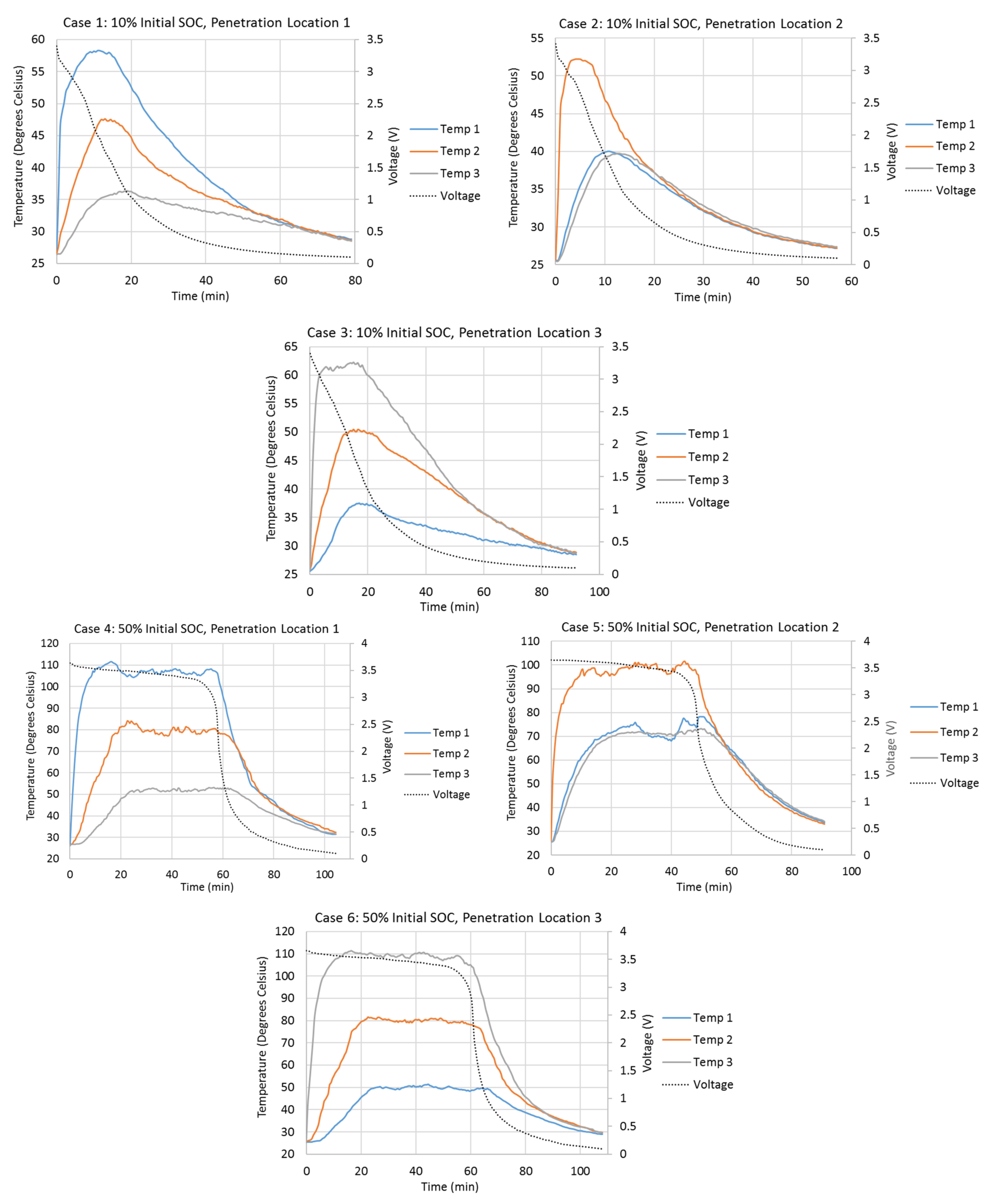
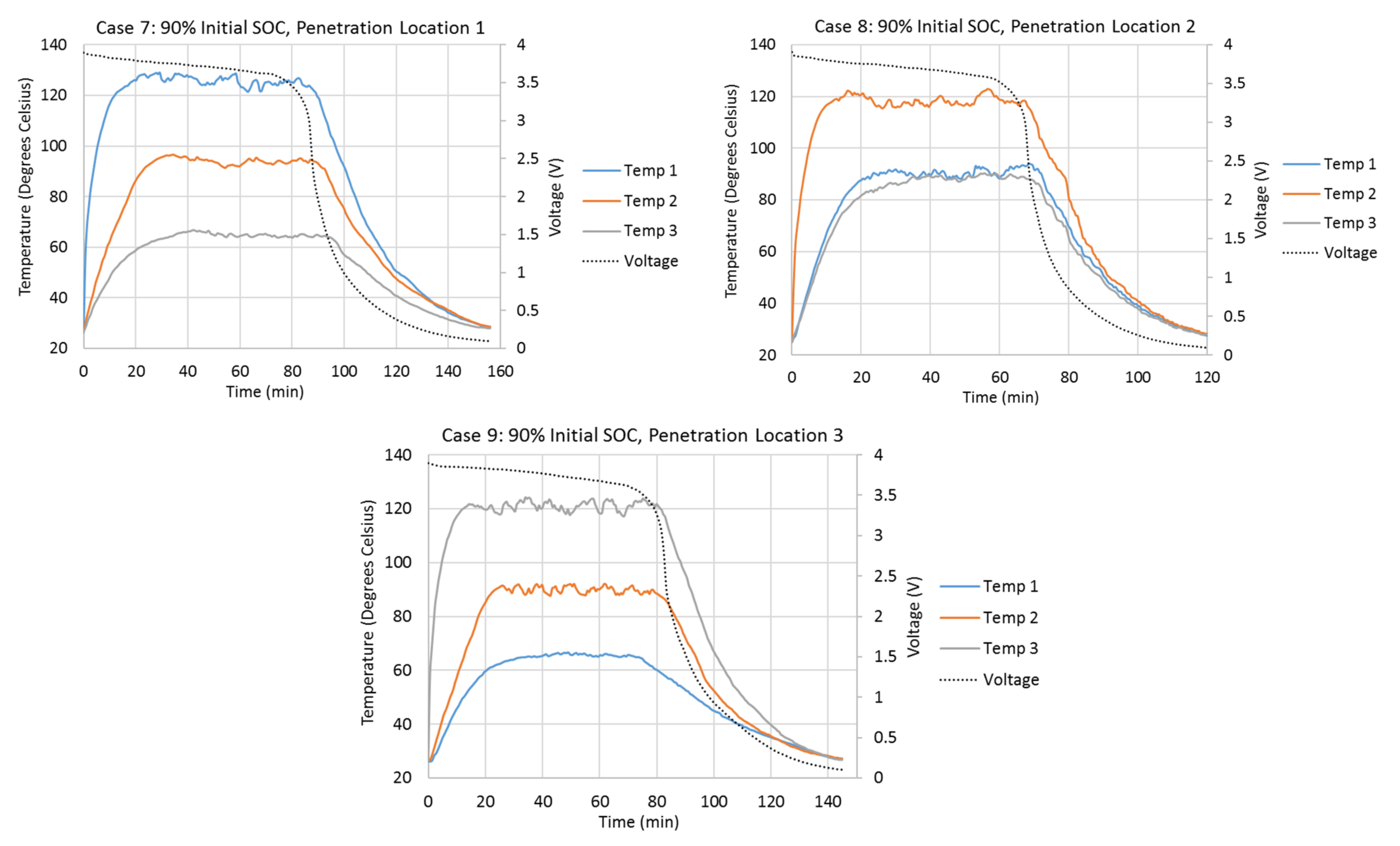
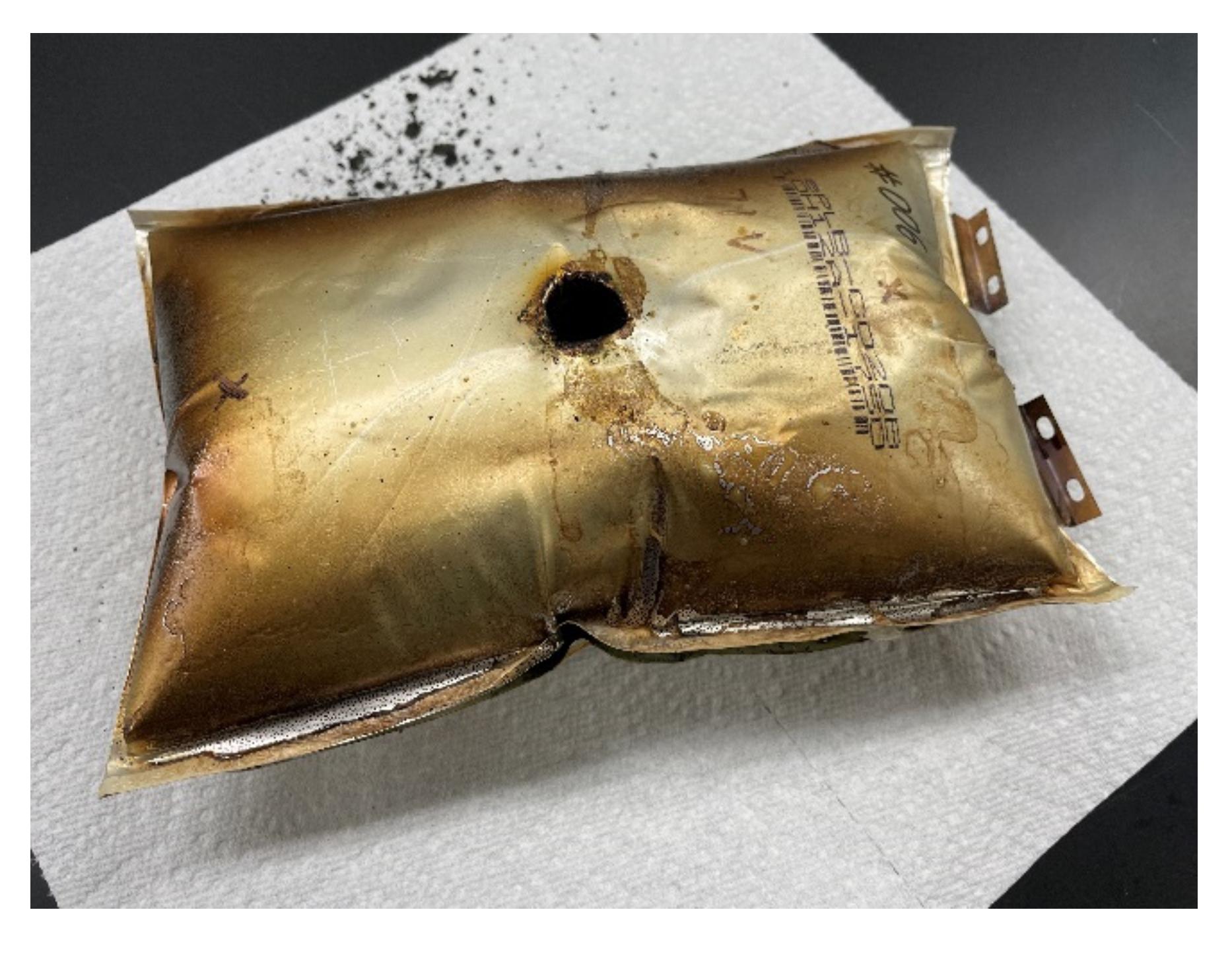
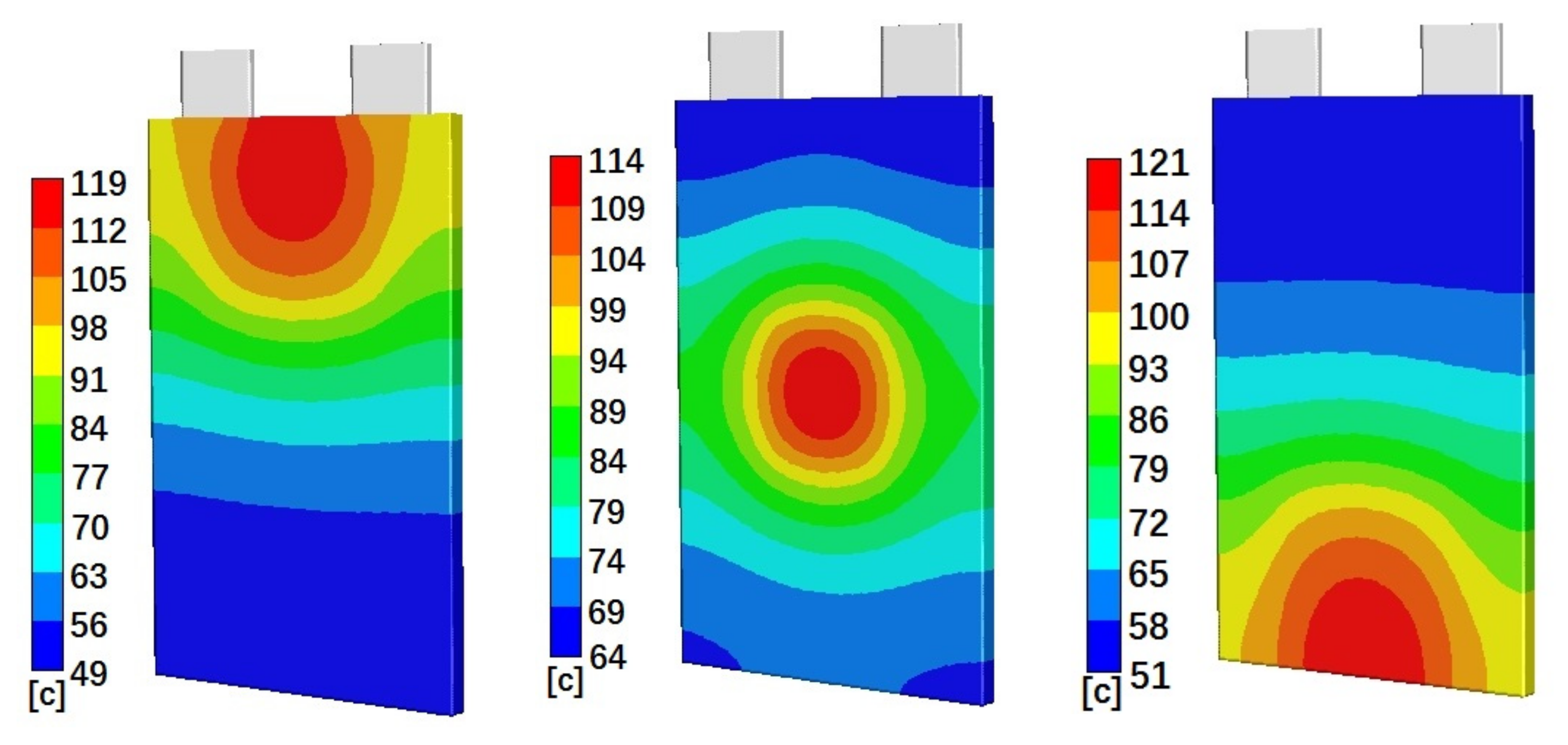
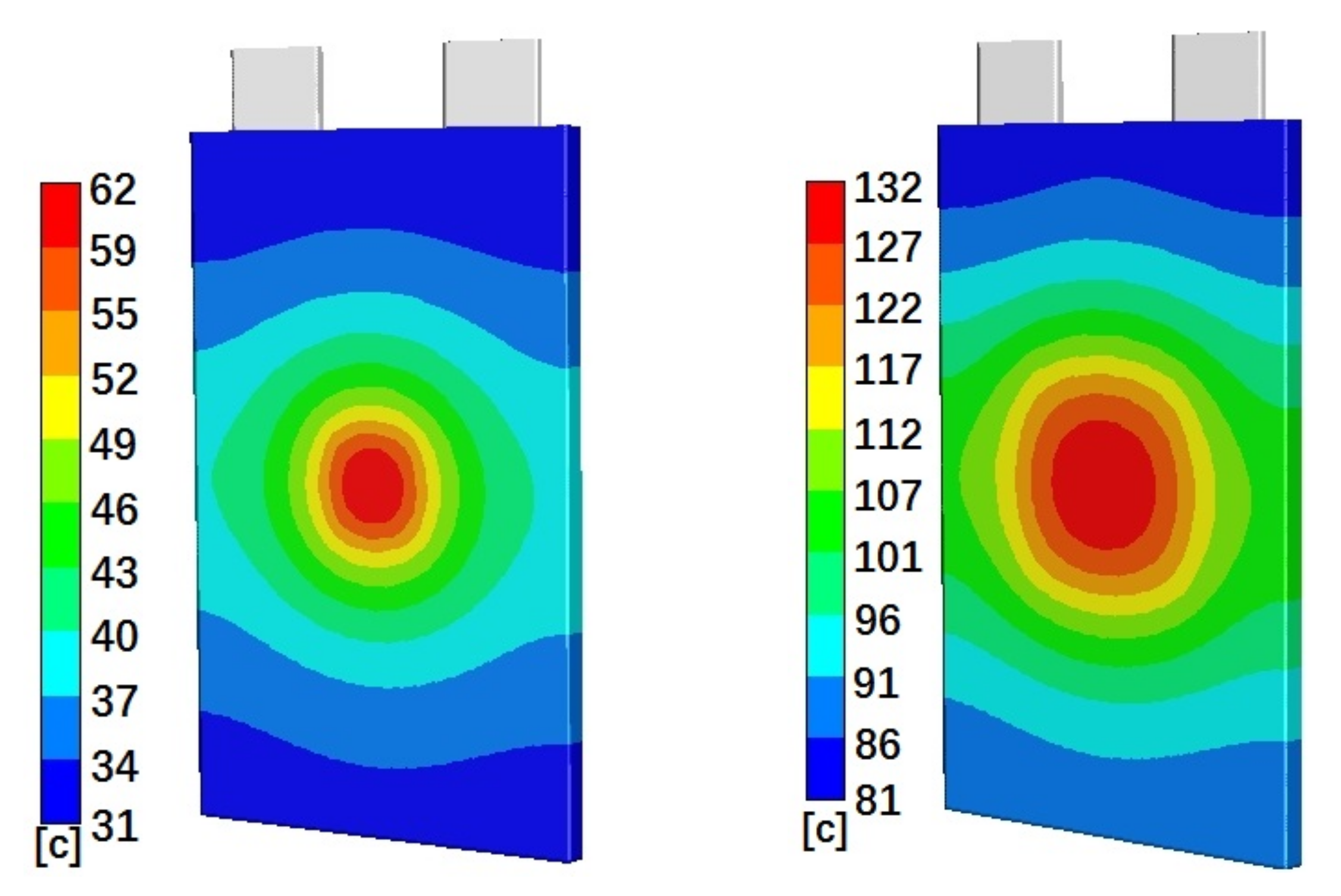
| Length | 196 mm |
| Width | 127 mm |
| Thickness | 7 mm |
| Weight | 428 g |
| Nominal Voltage | 3.65 V |
| Nominal Capacity | 20 Ah |
| AC Impedance (1 KHz) | <3 milliohm |
| Specific Energy | 174 Wh/Kg |
| Energy Density | 370 Wh/L |
| Specific Power (50%DOD, 10 s) | 2300 W/Kg |
| Power Density (50%DOD, 10 s) | 4600 W/L |
| Max. Charging Voltage | 4.15 V |
| Lower Voltage Limit for Discharge | 2.5 V |
| Cell Initial SOC | Penetration Location | |
|---|---|---|
| Case 1 | 10% | 1 |
| Case 2 | 10% | 2 |
| Case 3 | 10% | 3 |
| Case 4 | 50% | 1 |
| Case 5 | 50% | 2 |
| Case 6 | 50% | 3 |
| Case 7 | 90% | 1 |
| Case 8 | 90% | 2 |
| Case 9 | 90% | 3 |
| 10%-1 (Case 1) | 10%-2 (Case 2) | 10%-3 (Case 3) | 50%-1 (Case 4) | 50%-2 (Case 5) | 50%-3 (Case 6) | 90%-1 (Case 7) | 90%-2 (Case 8) | 90%-3 (Case 9) | |
|---|---|---|---|---|---|---|---|---|---|
| Initial Temp. of Penetration Location (°C) | 26.4 | 25.6 | 25.8 | 26.2 | 25.7 | 25.3 | 26.4 | 26.3 | 26 |
| Highest Temp. of Penetration Location (°C) | 58.3 | 52.2 | 62.3 | 111.5 | 101.5 | 111.5 | 128.9 | 123 | 124.3 |
| Temp. Increment of Penetration Location (°C) | 31.9 | 26.6 | 36.5 | 85.3 | 75.8 | 86.2 | 102.5 | 96.7 | 98.3 |
| Temp. at 80% of Temp. Increment of Penetration Location (°C) | 51.92 | 46.88 | 55 | 94.44 | 86.34 | 94.26 | 108.4 | 103.66 | 104.64 |
| Time Taken to Reach 80% of Temp. Increment of Penetration Location (min) (% of Test Duration) | 2.5 (3.2%) | 1.25 (2.2%) | 1.96 (2.1%) | 4.77 (4.6%) | 4.49 (4.9%) | 4.83 (4.5%) | 7.44 (4.8%) | 5.56 (4.6%) | 5.71 (3.9%) |
| Duration that Temp. above 80% of Temp. Increment of Penetration Location (min) (% of Test Duration) | 18.5 (23.4%) | 8.75 (15.4%) | 25.54 (27.8%) | 55.48 (53.1%) | 45.97 (50.5%) | 58.8 (54.4%) | 86.2 (55.3%) | 66.47 (55.4%) | 81.2 (56.0%) |
| Test Duration (min) | 79 | 57 | 92 | 104.5 | 91 | 108 | 156 | 120 | 145 |
| TC Location 1 | TC Location 2 | TC Location 3 | |||||||
|---|---|---|---|---|---|---|---|---|---|
| SIM | EXP | DIF | SIM | EXP | DIF | SIM | EXP | DIF | |
| 50% Initial SOC Penetration Location 2 (Case 5) | 70.4 | 72.7 | −2.3 | 103.8 | 100.2 | 3.6 | 73.1 | 71.7 | 1.4 |
| 50% Initial SOC Penetration Location 1 (Case 4) | 108.9 | 107.3 | 1.6 | 72.7 | 80.1 | −7.4 | 52.8 | 52 | 0.8 |
| 50% Initial SOC Penetration Location 3 (Case 6) | 53.6 | 50.2 | 3.4 | 69.3 | 80.5 | −11.2 | 108.8 | 110.3 | −1.5 |
| 10% Initial SOC Penetration Location 2 (Case 2) | 33.3 | 35.5 | −2.2 | 48.5 | 52.2 | −3.7 | 35.1 | 33.4 | 1.7 |
| 90% Initial SOC Penetration Location 2 (Case 8) | 87.3 | 89.5 | −2.2 | 122.4 | 117 | 5.4 | 91.5 | 89.2 | 2.3 |
Publisher’s Note: MDPI stays neutral with regard to jurisdictional claims in published maps and institutional affiliations. |
© 2021 by the authors. Licensee MDPI, Basel, Switzerland. This article is an open access article distributed under the terms and conditions of the Creative Commons Attribution (CC BY) license (https://creativecommons.org/licenses/by/4.0/).
Share and Cite
Liu, Y.; Li, Y.; Liao, Y.G.; Lai, M.-C. Effects of State-of-Charge and Penetration Location on Variations in Temperature and Terminal Voltage of a Lithium-Ion Battery Cell during Penetration Tests. Batteries 2021, 7, 81. https://doi.org/10.3390/batteries7040081
Liu Y, Li Y, Liao YG, Lai M-C. Effects of State-of-Charge and Penetration Location on Variations in Temperature and Terminal Voltage of a Lithium-Ion Battery Cell during Penetration Tests. Batteries. 2021; 7(4):81. https://doi.org/10.3390/batteries7040081
Chicago/Turabian StyleLiu, Yiqun, Yitian Li, Y. Gene Liao, and Ming-Chia Lai. 2021. "Effects of State-of-Charge and Penetration Location on Variations in Temperature and Terminal Voltage of a Lithium-Ion Battery Cell during Penetration Tests" Batteries 7, no. 4: 81. https://doi.org/10.3390/batteries7040081






